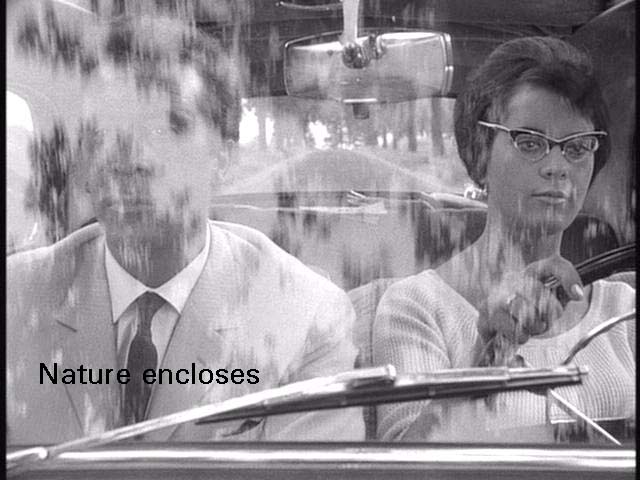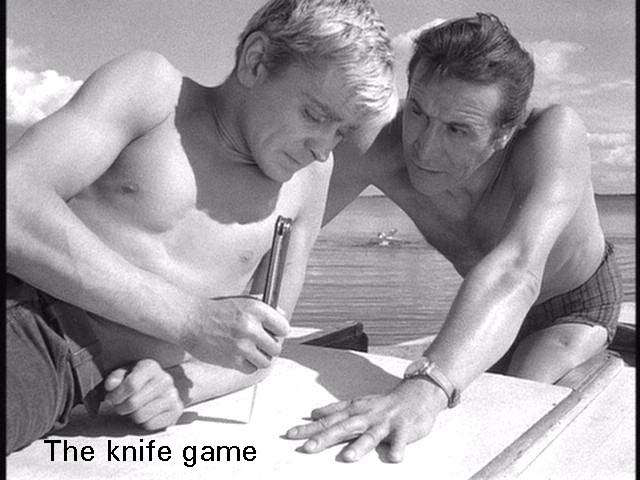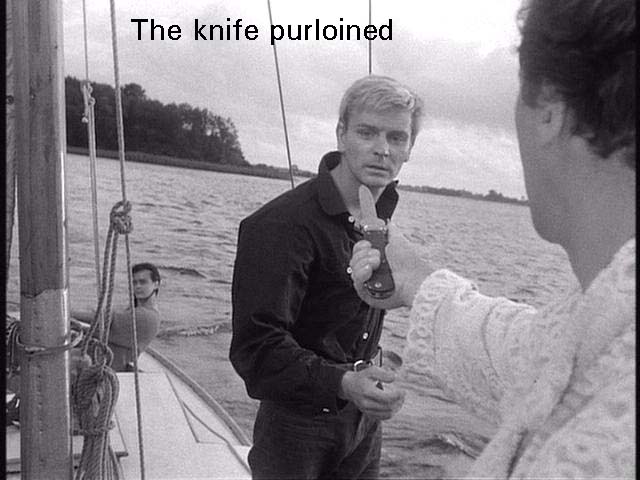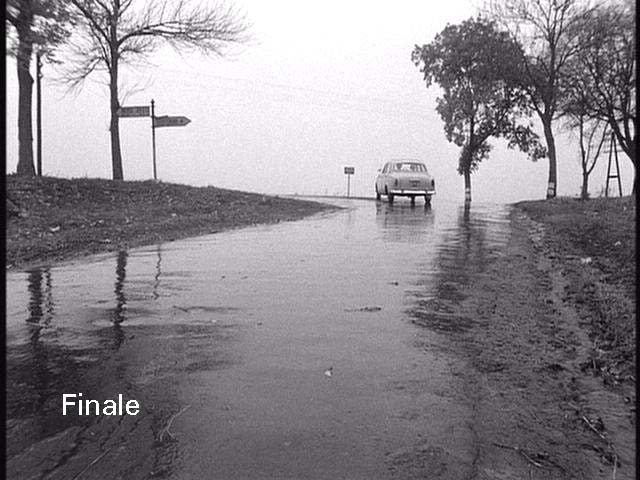You could hardly miss the main issue in this, Polanski’s first feature film. Two guys try to out-macho each other. Andrzej ( Leon Niemczyk) brakes just in time not to hit a nineteen-year-old boy (Zygmunt Malanowicz) who hitchhikes by standing in the middle of the road. Andrzej and his wife Krystyna (Jolanta Umecka) are driving in their fancy car to their fancy sailboat for a Sunday’s outing. Since the boy has scared him, Andrzej feels challenged and invites the boy-with-no-name to join them on their sail.
What ensues is a series of showings-off in a forest of phallic symbols. Who scares whom. Who knows how to sail. Who can give orders on the boat. Who can climb the mast. Who can haul the boat through reeds. Who can better throw the knife. Who wins at pick-up-sticks. Polanski includes triangles in his shots again and again, the bow of boat, the sails, the jackstraw heaps, the knife blade, the fingers in the knife game, shots between parted legs, and these echo the triangle of Andrzej and the boy, vying for Krystyna’s admiration and, ultimately, her sexual favors. Another way he does triangles is showing characters in the foreground and another much smaller character in the deep background. There are hidden triangles in the sight lines when we look through his eyes as the boy sights with first one eye, then the other, putting his finger on either side of the mast. Among the many phallic symbols are, not only these triangles, but the boy’s switch blade knife, the mast, an oar, a paddle, jackstraws, the logs at the end, Andrzej’s pipe and all his pipe tools, his gadget for holding a hot pan, and many others. At the end, the windshield wipers on his car have been stolen, completing his unmanning, at least symbolically. (He had dismissed the idea that they could be stolen.)
The tension between the two men grows and grows. Throughout, the film hovers on the edge of violence, which finally erupts when Andrzej causes the boy’s phallic knife to fall overboard. But the boy turns the tables. He wins the unannounced prize in this contest between the two men, Krystyna, who shares her name with the boat on which the contest is fought. The boy wins both boat and woman. In a curious way, Polanski, writing for a highly Catholic country, rationalizes Andrzej’s defeat.
Polanski sets the boy up as a Christ-figure. He lies on the deck in the posture of the crucifixion, his head haloed by a coiled rope (that Andrzej, as part of his bullying, had made him coil). He seems to walk on the water, and he undergoes an apparent death and rebirth. Seen in this perspective, Andrzej’s bullying comes across as persecution of an innocent, although the boy hardly turns the other cheek.
My advice to filmgoers is: always look at the opening scene and the closing scene. Like the first and last words of a poem or novel, the auteur chooses them with special care. Here Polanski focuses on the windshield of the car, reflecting the trees along the road as Andrzej breaks the speed limit. And, at the end, the car sits at a crossroads as Andrzej tries to decide whether to go to the police or not. Polanski is reminding us that the claustrophobic world, two people in a car, three people on a boat, becalmed or moored for a storm, this microcosm exists within a much larger world of nature and society. The boy hikes in nature; the man sails in it.
That enclosing, it seems to me, is the moral (so to speak) of the story of the seaman jumping onto broken glass and sending blood everywhere. Despite his posturing, he is never heard from again, demonstrating the futility of these macho games. The men's threatening and picking at each other in their tight little world takes place in a much larger cosmos within which their squabbling seems petty indeed. Yet, Polanski, by his tight photography and big close-ups, keeps us focused on the battle, while the background remains calm and mute, as though the potential for violence is what interests him.
Poised against the two strutting males, Krystyna is calm and self-contained, quietly powerful, like the natural surround. (“Bovine” is the word Polanski used for her in an interview.) Ultimately she is the one who wins the contest. Her name identifies her with the boat, one more of Andrzej’s possessions, but it also suggests that she belongs to the Christ-figure boy. She is the one close to nature, who enjoyed her swim with the inflatable toy and who calls out what to do when the boat gets out of the boy’s control. In that dangerous situation, by contrast, Andrzej foolishly tries to swim to the boat and show off his masterful sailing compared to the boy’s ineptitude.
The two males’ competition becomes small and ridiculous in the larger, more powerful and dangerous world they inhabit. It seems strange to me that Polanski should frame this macho struggle in such a contemptuous way. After all, he himself is deeply attracted to violence, portraying himself as a bullying thug in Two Men and a Wardrobe and Chinatown. He arranged a nasty fight so that he could film Break Up the Dance. Could one say that his art enables him to get beyond himself?



